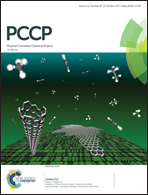Interface and interaction of graphene layers on SiC(000![[1 with combining macron]](https://www.rsc.org/images/entities/char_0031_0304.gif) ) covered with TiC(111) intercalation†
) covered with TiC(111) intercalation†
Abstract
It is important to understand the interface and interaction between the graphene layer, titanium carbide [TiC(111)] interlayer, and silicon carbide [SiC(000![[1 with combining macron]](https://www.rsc.org/images/entities/char_0031_0304.gif) )] substrates in epitaxial growth of graphene on silicon carbide (SiC) substrates. In this study, the fully relaxed interfaces which consist of up to three layers of TiC(111) coatings on the SiC(000
)] substrates in epitaxial growth of graphene on silicon carbide (SiC) substrates. In this study, the fully relaxed interfaces which consist of up to three layers of TiC(111) coatings on the SiC(000![[1 with combining macron]](https://www.rsc.org/images/entities/char_0031_0304.gif) ) as well as the graphene layers interactions with these TiC(111)/SiC(000
) as well as the graphene layers interactions with these TiC(111)/SiC(000![[1 with combining macron]](https://www.rsc.org/images/entities/char_0031_0304.gif) ) were systematically studied using the density functional theory-D2 (DFT-D2) method. The results showed that the two layers of TiC(111) coating with the C/C-terminated interfaces were thermodynamically more favorable than one or three layers of TiC(111) on the SiC(000
) were systematically studied using the density functional theory-D2 (DFT-D2) method. The results showed that the two layers of TiC(111) coating with the C/C-terminated interfaces were thermodynamically more favorable than one or three layers of TiC(111) on the SiC(000![[1 with combining macron]](https://www.rsc.org/images/entities/char_0031_0304.gif) ). Furthermore, the bonding of the Ti-hollow-site stacked interfaces would be a stronger link than that of the Ti-Fcc-site stacked interfaces. However, the formation of the C/Ti/C and Ti/C interfaces implied that the first upper carbon layer can be formed on TiC(111)/SiC(000
). Furthermore, the bonding of the Ti-hollow-site stacked interfaces would be a stronger link than that of the Ti-Fcc-site stacked interfaces. However, the formation of the C/Ti/C and Ti/C interfaces implied that the first upper carbon layer can be formed on TiC(111)/SiC(000![[1 with combining macron]](https://www.rsc.org/images/entities/char_0031_0304.gif) ) using the decomposition of the weaker Ti–C and C–Si interfacial bonds. When growing graphene layers on these TiC(111)/SiC(000
) using the decomposition of the weaker Ti–C and C–Si interfacial bonds. When growing graphene layers on these TiC(111)/SiC(000![[1 with combining macron]](https://www.rsc.org/images/entities/char_0031_0304.gif) ) substrates, the results showed that the interaction energy depended not only on the thickness of the TiC(111) interlayer, but also on the number of graphene layers. Bilayer graphene on the two layer thick TiC(111)/SiC(000
) substrates, the results showed that the interaction energy depended not only on the thickness of the TiC(111) interlayer, but also on the number of graphene layers. Bilayer graphene on the two layer thick TiC(111)/SiC(000![[1 with combining macron]](https://www.rsc.org/images/entities/char_0031_0304.gif) ) was thermodynamically more favorable than a monolayer or trilayer graphene on these TiC(111)/SiC(000
) was thermodynamically more favorable than a monolayer or trilayer graphene on these TiC(111)/SiC(000![[1 with combining macron]](https://www.rsc.org/images/entities/char_0031_0304.gif) ) substrates. The adsorption energies of the bottom graphene layers with the TiC(111)/SiC(000
) substrates. The adsorption energies of the bottom graphene layers with the TiC(111)/SiC(000![[1 with combining macron]](https://www.rsc.org/images/entities/char_0031_0304.gif) ) substrates increased with the decrease of the interface vertical distance. The interaction energies between the bottom, second and third layers of graphene on the TiC(111)/SiC(000
) substrates increased with the decrease of the interface vertical distance. The interaction energies between the bottom, second and third layers of graphene on the TiC(111)/SiC(000![[1 with combining macron]](https://www.rsc.org/images/entities/char_0031_0304.gif) ) were significantly higher than that of the freestanding graphene layers. All of these findings provided insight into the growth of epitaxial graphene on TiC(111)/SiC(000
) were significantly higher than that of the freestanding graphene layers. All of these findings provided insight into the growth of epitaxial graphene on TiC(111)/SiC(000![[1 with combining macron]](https://www.rsc.org/images/entities/char_0031_0304.gif) ) substrates and the design of graphene/TiC/SiC-based electronic devices.
) substrates and the design of graphene/TiC/SiC-based electronic devices.
![Graphical abstract: Interface and interaction of graphene layers on SiC(000 [[1 with combining macron]] ) covered with TiC(111) intercalation](/en/Image/Get?imageInfo.ImageType=GA&imageInfo.ImageIdentifier.ManuscriptID=C7CP04443G&imageInfo.ImageIdentifier.Year=2017)


 Please wait while we load your content...
Please wait while we load your content...
![[1 with combining macron]](https://www.rsc.org/images/entities/h2_char_0031_0304.gif) ) covered with TiC(111) intercalation
) covered with TiC(111) intercalation